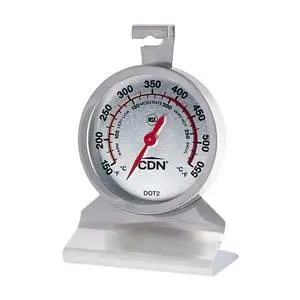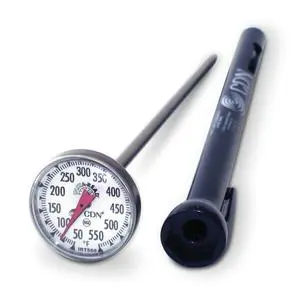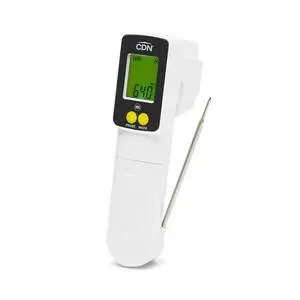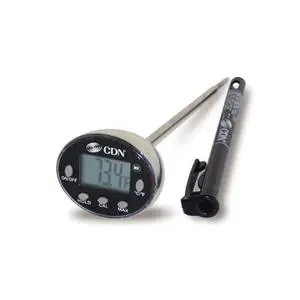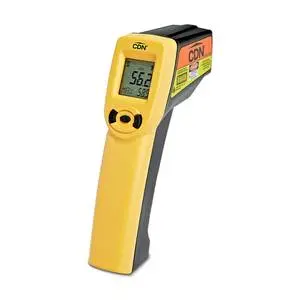We have all heard the horror stories of restaurant goers getting sick from eating that one badly cooked piece of meat at their favorite restaurant, or worse, we have experienced it ourselves. If feels awful. In most cases involving feelings of nausea, vomiting, high fevers and terrible stomach cramps. Most people don’t even realize that their illness is caused by a food-born pathogen or bacteria most likely due to poorly cooked food.
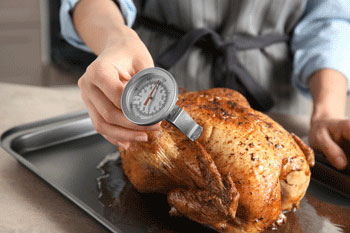
The USDA estimates that foodborne illnesses affect 48 million people each year and cause about 3,000 deaths in the United States. However, most foodborne illness can be prevented with proper cooking. Most pathogenic bacteria are destroyed between 140° F and 160° F (60° C to 71°C).
Enter thermometers.
Anyone who grills, roasts or sautés meat, brews quality coffee or bakes knows the benefits of owning a thermometer. It not only keeps food safe from harmful bacteria, but it also helps to avoid overcooking.
Here, we will explore the different types, functions, advantages and disadvantages of thermometers to help you improve the efficiency of your kitchen and give you some piece of mind before purchasing a new tool.
First things first, digital vs. analog thermometers. Analog (liquid filled) thermometers are still widely used in the industry because they do not require batteries and are very easy to calibrate, but they give approximate temperature readings over more specific temperatures. Digital thermometers are the preferred tool of choice within the industry because they provide more accurate read outs, usually have easy-to-read displays and some even come with alarms that indicate when a preset temperature is reached, but they do require batteries and can be hard to calibrate.
Thermometers should generally read up to 2 degrees Fahrenheit for accuracy. This can be tested by placing a thermometer in a pot of boiling water (water boils at 212° F or 100°C) and if it registers within 2 degrees in either direction, it is working properly. The same can be done for cold foods or freezer thermometers by sticking the thermometer in a glass of ice water and measuring within one degree of 32°F or 0°C.
There are five different thermometer types:
- Bimetal
- Glass Column
- Digital – Thermistor
- Digital – Thermocouple
- Infrared
Bimetal
These thermometers are constructed of two different types of metals that are wound in a coil shape, which expand at different rates as the thermometer is heated and cooled. The movement correlates to the actual temperature and moves an indicator along the attached scale. They can take as long as 1-2 minutes to register the correct temperature and have many uses, from thick roast beef or chicken to thin foods like soups, stocks and coffee beverages—basically everything.
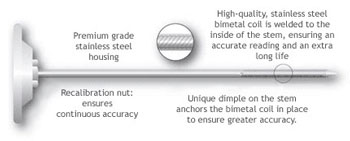
CDN Bimetal INSTA-READ® pocket thermometers are a top choice for many professional chefs for their quick response times of 15 to 20 seconds and accuracy in adapting to temperature changes. These analog types are more cost-effective than digital thermometers because they don’t require batteries and are widely used.
Glass Column Thermometers
These types of analog thermometers consist of a food-safe fluid sealed in a glass tube with a reservoir at the bottom that contains the bulk of the fluid, which expands and contracts as the temperature changes. A temperature scale is positioned near the column to provide an approximate temperature read.

These thermometers come in both glass and plastic varieties and are both the most and least expensive types in the market. The differences lie in the quality of the glass and fluid, and how it’s calibrated at the factory. Most are easy to understand and are very economical, but glass models can break and it’s common for the liquid to separate (which can be fixed). These types are great for tempering chocolate, candy and can be used for deep frying, as well as freezer storage. All CDN glass column thermometers are individually calibrated at the factory for the most accurate readings.
Digital Thermometers – Thermistor
A thermistor is a type of digital thermometer that uses a thermally sensitive object (or sensor) the size of a head of a pin located at the tip. When voltage is applied, the temperature is calculated based on how the electrons move in response to the energy current. The speed of response will tell you how reliable the unit will be. The industry standard is a response rate of 10 seconds or less. These are very popular because they are generally less expensive than other digital thermometers
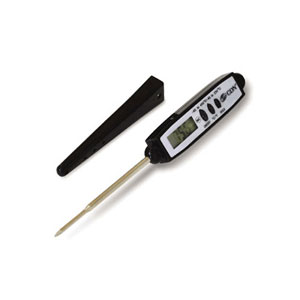
CDN offers a ProAccurate® Quick-Read™ meat-and-poultry thermometer with a stable repose rate between 6 and 8 seconds. All CDN thermistor units offer one-button, easy calibration in as little as two seconds and have thinned tips for easy insertion.
Digital thermometers - Thermocouple
Thermocouple thermometers are by far the most widely used in the foodservice industry due to their rapid response rates (about two seconds) and ability to produce readings in higher temperatures (250° C and above).
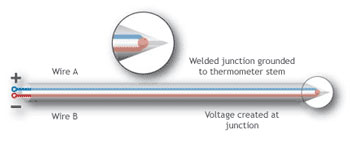
Thermocouple is a probe device that is made of two different types of metal wires that act as electrical conductors, joined together at one end and connected to a voltage-measuring device at the other. The thermometer quickly generates electricity when heat is applied to its tip, and the voltage is expressed in the temperature reading.
These thermometers are designed to check final cooking temperatures, and not to stay in food while cooking. Because of their speedy response, they can be used quickly to check the temperature in several places on large food items like turkeys and roasts. They are also useful for foods such as hamburgers and pork chops because of their thin probe.
Thermocouples come in different calibration types due to different metals being used. The maximum temperature changes with the diameter of the wire used in the probe. These are typically more expensive than bimetal or digital thermometers, but they respond to temperature changes more quickly than others and can reach a maximum of 1,000° F with some models.
Infrared Thermometers
An Infrared thermometer is a cool-looking, gun-shaped tool with a built-in laser pointer that uses infrared technology to measure surface temperature at a distance… with an emphasis on surface temperature readings only.

These types work to remotely tell temperature when it’s not possible or practical to physically contact the object being measured, say, if reading the temperature of hot oil, a cast iron skillet or the surrounding temperature of a grill, oven, etc. This method of reading temperature also helps to eliminate the possibility of cross contamination. However, it does not work well on shiny surfaces or gold.
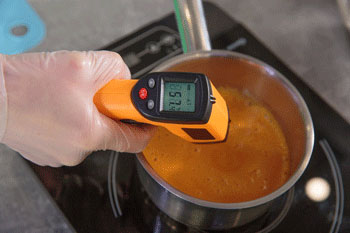
The laser-pointer technology uses infrared light rays to measure the amount of infrared radiation (between microwave and ultraviolet radiation) emitting from an object. When the laser is pointed at an object, the thermometer reads the temperature above, below or around where the laser is pointed and provides an instantaneous reading of the surface area. Depending on the optics of the infrared thermometer, the diameter of the area being measured will change based on how close or far the thermometer is from the object.
Although we can’t see infrared radiation, we have all experienced it as heat, whether it be sitting in front of a bonfire or inside of a hot car on a sunny day.
CDN offers a model that combines infrared and non-contact thermocouple technologies in a single tool to ensure the best results for food safety in commercial kitchens – view it here.
Speaking of food safety… The best way to prevent cross-contamination with the use of a probe or pocket thermometer is to keep a few tubes of sanitizing probe wipes on hand, or clean with soapy water between use. Be smart. Keeps foods apart.
It is also important to note that when using induction cooktops, the magnetic field may interfere with all digital thermometers. This can be avoided by briefly turning off the induction cooktop to get an accurate reading or by using a dial (bimetal) thermometer. Before using any thermometer, always read the manufacturer instructions.
Enjoyed this article? Click here to stay up-to-date on industry news and receive exclusive sales and promotions.



